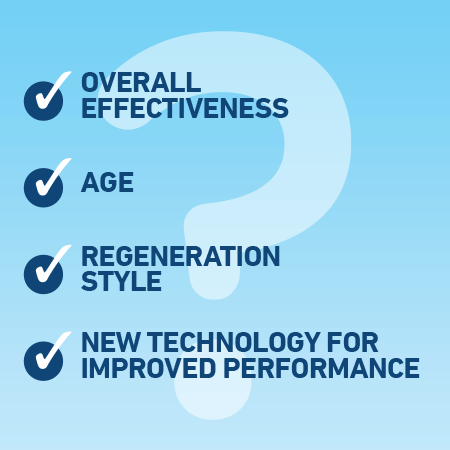Knowing when to upgrade your softener
A water softener is a pretty unassuming appliance, and once you install it, it’s easy to overlook it when conducting home improvements. Unless the color of your water softener mimics something from the disco era (we’re talking harvest gold or avocado green), the indicators that suggest it may be time for an upgrade are much more subtle. Below are several factors to consider when determining whether it’s time to go out with the old and in with the new.

Overall Effectiveness
If you’re diligent about adding and monitoring your salt, yet water isn’t coming out as soft as it once did (and should!), the resin beads, which actually soften the water, may be starting to lose their power. While resin cleansers are available to get the beads back in top working form, in time the beads just get worn out. And when the beads are worn out, they fail to do their job well. It’s much more cost-effective to get a completely new water softener.
Age
Like any appliance, a water softener’s efficacy starts declining after years of constant use. A softener’s average lifespan is about 10-15 years, give or take. If your water is abnormally hard or full of other impurities, it takes a greater toll on the appliance much more quickly. If your water is low to moderately hard, it won’t have to be regenerated as often, extending the life of the appliance a few more years beyond the average lifespan.
Regeneration Style
Regeneration, the process that removes calcium and magnesium from the resin beads, can occur in two different ways.Timer-based water softeners regenerate on a predetermined schedule that you will set (e.g., at 2 a.m. every three days). These models aren’t ideal if your water usage varies. If you underestimate your water usage (i.e., extra loads of laundry, extra guests), and your water softener regenerates too infrequently, you will allow hard water to flow throughout your home. On the flip side, overestimating your water use will result in unnecessary regeneration, wasting water, salt and energy.
The most user-friendly regeneration style is a demand-initiated regeneration softener. Sensors in this system monitor water usage. When the resin is full of hardness minerals and requires cleansing, the softener regenerates on its own. Unlike timer-based softeners, the process occurs only when you need more soft water. This type of softener is ideal because it works on an as-needed basis, saving energy, water and salt use over the life of the appliance. Some of the more advanced softeners even learn your water use patterns to further optimize the regeneration frequency.
New Technology for Improved Performance
When assessing all the different models available, you’ll find softening options with single “cabinet-style” tanks and twin tanks, and plenty of helpful features.
More modern single-tank demand-initiated water softeners require less space, water and salt. They also include features that make maintenance a breeze, like low salt indicators, iron removal for clear water iron and water flow indicators. Some of the more advanced models also show your daily water use compared to your average use so that you can better manage your household water consumption.
Two-tank systems are more costly, require more space, and may ultimately use more water and salt to get the job done. Additionally, this style is not always able to accommodate some of the newer upgrades because of the additional tank. The benefit with this model is that because this system has two tanks instead of one, when one tank has reached its capacity and needs to regenerate, the other one can take over, ensuring a constant flow of soft water.
With a variety of new features to fit your household needs, it makes owning and operating a water softener even easier—and a financially sound investment.

